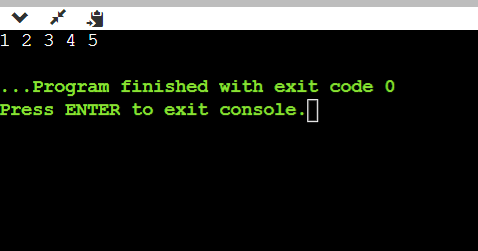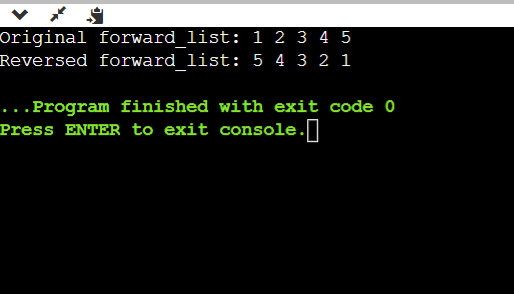forward_list::reverse() in C++The singly linked list forward_list has a unique set of member functions. Reverse() is one of these functions that is particularly useful for rearranging the elements in a list.
Program:Output: 
Explanation: The code is explained as follows:
The Requirement to Reverse a List:
Forward_list::reverse() syntax:The usage of the forward_list::reverse() function is really simple. It is called on an instance of a forward_list and is a member function of the forward_list class. The following is the syntax: The function doesn't throw exceptions and doesn't accept any arguments, as indicated by the no-exception specifier. It is consistent with the C++ Standard Library's overarching goal of delivering reliable and effective behavior. Let's observe how forward_list::reverse() works: Program:Output: 
Explanation: Here is the explanation for the above code:
The effectiveness of reverse_list::forward():
Use Cases:It's crucial to know when to use forward_list::reverse() while building legible and efficient code. Here are some situations in which this function may come in handy: Algorithm Improvement: Reversing the order of the data may help some algorithms. For instance, algorithms utilizing recursion or backtracking might function better on a reversed sequence. Presentation and User Interface: The arrangement of items can greatly affect the user experience when working with presentation layers or graphical user interfaces. Reversing a list could be helpful when presenting historical data, logs, or any other situation where it is beneficial to provide information in reverse chronological order. Manipulation of linked lists: Reversing forward_list can be useful when working with specific algorithms or situations that call for linked list manipulation because it is a linked list. Conclusion:In conclusion, a strong and effective method for reversing the order of elements within a singly linked list is offered by the forward_list::reverse() function in C++. This method is part of the Standard Template Library's (STL) std::forward_list class. It provides a simple syntax with an O(n) time complexity-where n is the number of members in the list. Because of its effectiveness, this operation is a useful tool for situations where reversing a linked list is necessary, such as when optimizing algorithms, getting ready to show data, or working with linked list structures. When working with singly linked lists, knowing about and utilizing forward_list::reverse() can help write C++ code that is more efficient and clear.
Next Topicios::setstate() function in C++
|
 For Videos Join Our Youtube Channel: Join Now
For Videos Join Our Youtube Channel: Join Now
Feedback
- Send your Feedback to [email protected]
Help Others, Please Share









